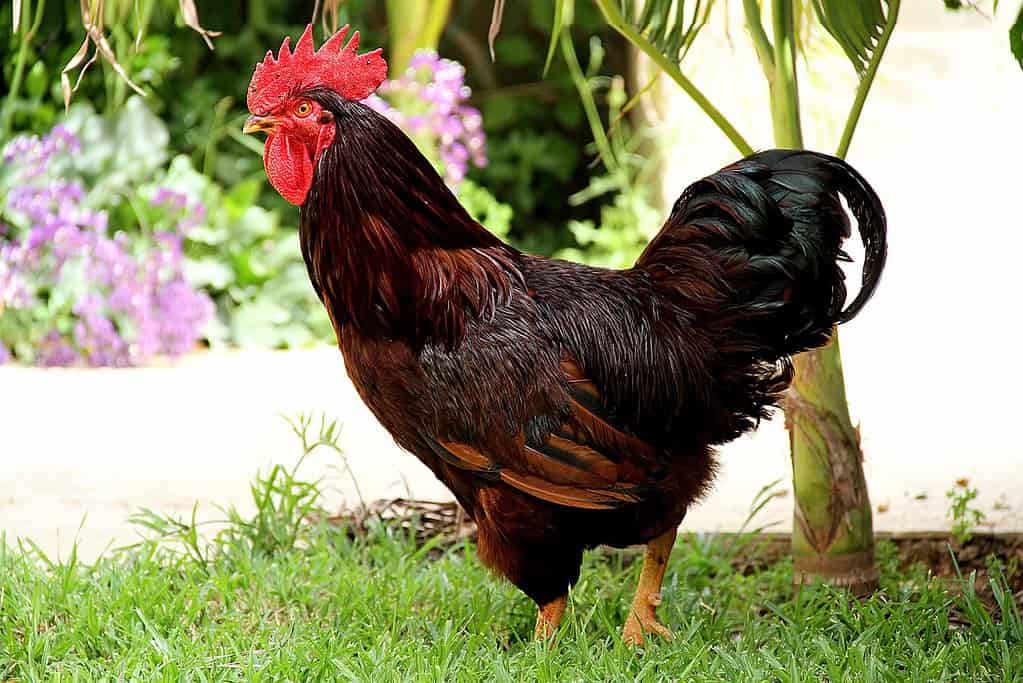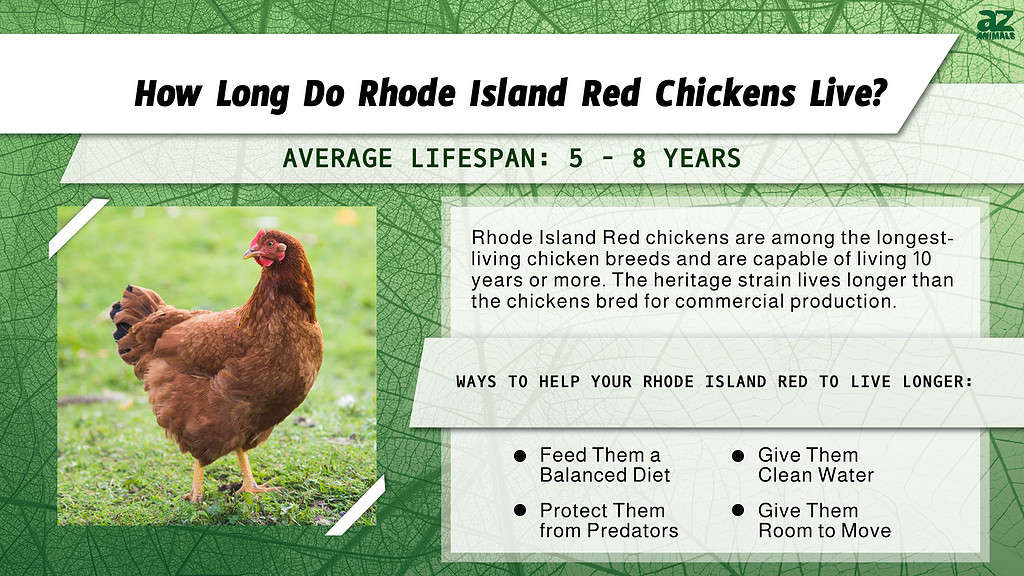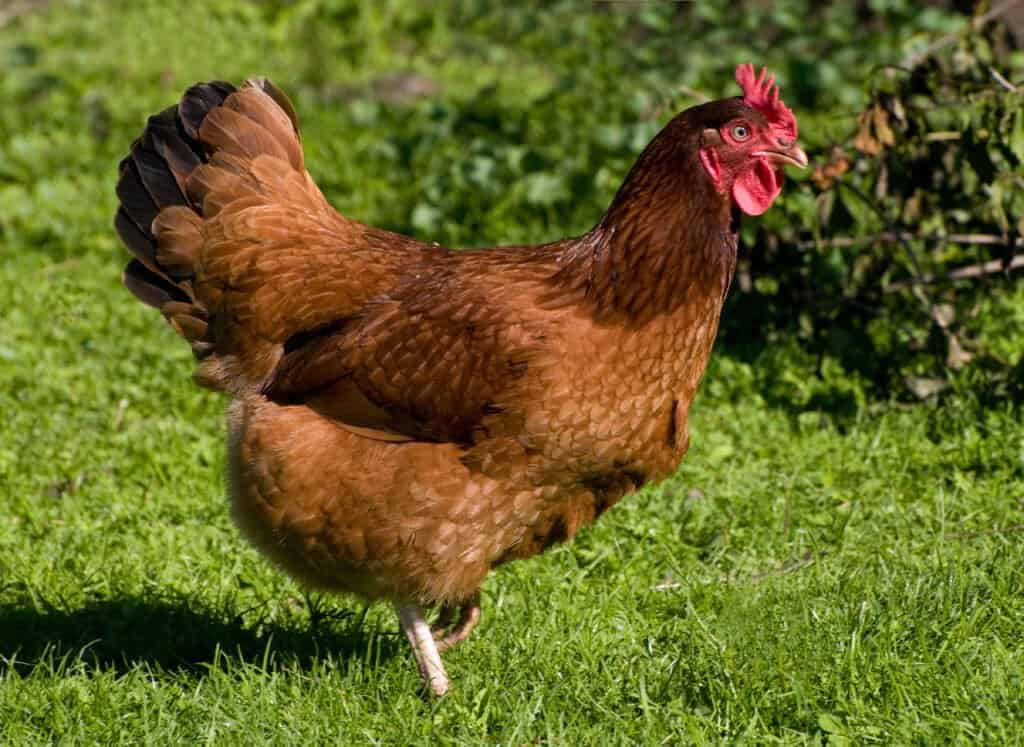The Rhode Island Red chicken is a popular dual-purpose breed originally bred in Rhode Island and Massachusetts in the mid-1800s. This large breed produces up to 300 eggs per year and a substantial amount of tender meat. Originating from crosses between Leghorn chickens and Asian breeds including the Malay, the Rhode Island Red is a hardy breed. Its numbers have grown so much that it graduated from the Conservation List of the Livestock Conservancy in early 2023. Rhode Island Red chickens can withstand a wide range of temperatures, resist predators, and tolerate confinement. Among its desirable traits, the Rhode Island Red chicken’s lifespan and productivity help set it apart from other breeds.

Rhode Island Red chickens are a hardy breed.
©Vitag, CC BY-SA 3.0 <https://creativecommons.org/licenses/by-sa/3.0>, via Wikimedia Commons – Original / License
How Long Do Rhode Island Red Chickens Live?
Rhode Island Red chickens have an impressive lifespan. They live five to eight years on average, but with proper care, they can live 10 years or more. Their lifespan ranks among the longest-living chicken breeds, comparable to the Orpington chicken, but not quite as long as the Old English Game chicken or the Plymouth Rock.
The heritage strain of the Rhode Island Red chicken lives longer on average than the strain bred for commercial production. Perhaps the strain of laying such large quantities of eggs takes its toll on the hens of the production variety.

Egg Production Over Time
Hens of the production variety of Rhode Island Red chickens lay more eggs per week than their heritage variety counterparts. Production hens can lay up to 300 eggs per year or more. The heritage variety hens lay roughly 200 eggs per year on average. However, the heritage hens tend to live longer and continue producing eggs longer than the production variety, so owners should weigh the pros and cons of each.

Rhode Island Red hens lay between 200 to 300 eggs per year.
©Ariene Studio/Shutterstock.com
Ways to Maximize the Rhode Island Red Chicken Lifespan
You can take steps to increase the lifespan of your Rhode Island Red chickens. Some of these strategies may improve the quality of their life as well. Note that while these methods also apply equally well to most breeds of chickens, genetics play a large role in determining the lifespan of the Rhode Island Red chicken and others.
Feed Them a Balanced Diet
Rhode Island Red chickens need a well-balanced diet to support their large bodies and high egg production. Feeding them the right balance of protein, carbohydrates, vitamins, and minerals ensures that they will maintain a healthy weight and live as long as possible. The best way to manage their diet is to consistently feed them high-quality commercial feed. Supplement their diet with small amounts of healthy snacks at a ratio of 90 percent feed to 10 percent treats. Healthy treats include leafy green vegetables, many kinds of fruits, certain grains and seeds, bits of meat, and more. Make sure you know what foods are safe to feed chickens and what foods chickens should not eat. Feeding your birds the wrong treats can significantly shorten their lifespan.
Give Them Clean Water
Rhode Island Red chickens need plenty of clean, fresh water. They don’t have excess feathers on their heads or their feet, so they can drink from most kinds of containers. Refill their water frequently when it is hot outside, and make sure it doesn’t freeze in the winter.
Protect Them from Predators
Rhode Island Red chickens are large birds, but they are also quick and agile. They do a good job of staying alert, so they can generally range freely during the day. However, a fenced enclosure will provide your flock with greater security. Your chickens also need a completely secure coop to protect both adult birds and chicks at night.
Give Them Room to Move
When planning a coop, remember that Rhode Island Red chickens, as a heavy breed, need at least 4 square feet of space per bird. That means a coop that measures 4 feet by 8 feet would be sufficient for only about eight chickens at most. Giving your chickens adequate space helps prevent disease and aggression.
Avoid Diseases
Like other chickens, Rhode Island Reds can succumb to a number of diseases. Providing proper care for your flock includes making sure they are vaccinated and dewormed. Look for signs of unhealthy chickens. Remove any chickens suffering from diarrhea, lethargy, feather loss, or other symptoms of illness from the flock. Contact your veterinarian if home care does not help the bird improve. You may need to cull sick birds in order to protect the rest of the flock from contagious diseases.
How Long Should You Keep an Old Chicken?
Rhode Island Red chickens are reportedly very tasty birds, even when they get old. This begs the question, how long should you keep an older chicken around? Rhode Island Red hens produce eggs longer than many other breeds. They may still produce eggs at age six or older, but the number of eggs they lay each year will decline after they pass their prime. Once a hen stops laying, is it worth the cost of feed to keep her around?
The answer to that question is completely personal and really depends on whether you see your flock as pets or food. Some owners cull roosters as soon as they are big enough to make a decent meal, and cull hens when their egg production slacks off enough that they are no longer profitable. Others allow their hens and at least some roosters to live out whatever lifespan they may naturally reach. Either way, for the time that you have them, you should treat your chickens well and try to give them the best life possible.
The photo featured at the top of this post is © Nadanka/iStock via Getty Images
Thank you for reading! Have some feedback for us? Contact the AZ Animals editorial team.







